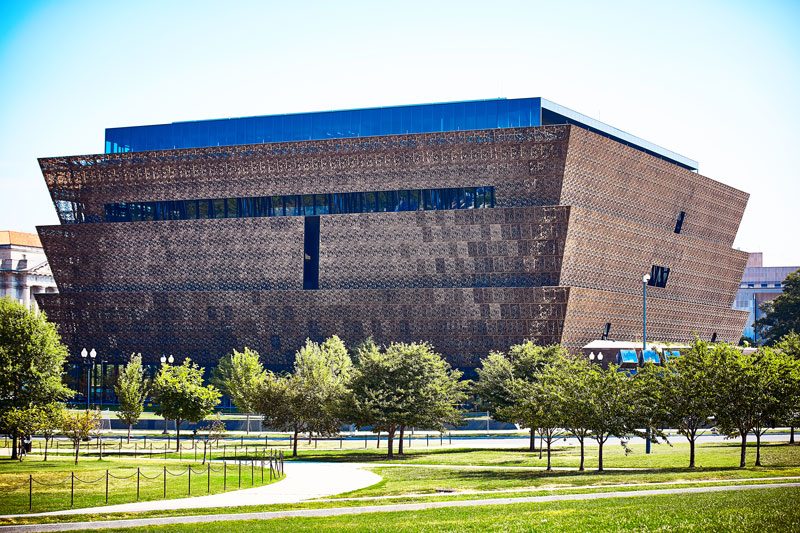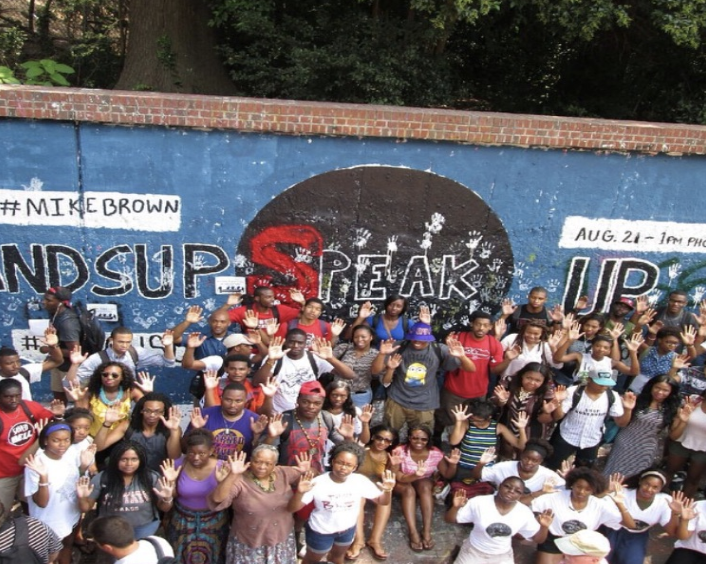Rooted in History Contextualized by the People: African-American Design Thinking
Posted on October 26, 2018Rooted in History Contextualized by the People:
African-American Design Thinking
Social Justice and Leading the Charge
Designing as an Extension of an Enduring People

Image Source: https://washington.org/visit-dc/things-need-know-smithsonian-national-museum-african-american-history-culture
Transdisciplinary design emphasizes a collaborative, systems-oriented approach to design and social thought. As we explore such a field it is important to recognize moments in history where this work has been embodied and practiced before. This shift in design must enter the conversation of history, proper use, and acknowledge the true champions of aligning justice and design.
Emergent systems is a concept we have begun to analyze.[1] The idea of an emergent system is a concept we have explored and seems to be the most prominent topic in our discourse. Cornwall argues “To put it more provocatively, I would argue that design is one of the terms that has replaced the word “revolution”!”[2] Design as a Manifested Being and Necessity for positive change. A true exploration of what it perhaps means to design and address pressing social, economic, political, and environmental issues and challenges. Yet, what does it mean to design as a part of an emergent system?
This call – is a way of life and design that is all too familiar to my community, ancestors, and more. Therefore, I realize such a theory and practice is not new. Yet, the world of design aims to venture into this space. Design can be a great vehicle, yet it must be careful to acknowledge and learn from champions that come before them. There are many examples of such, but in this case of America I will highlight African American history and design.
I feel called to understand this, yet find myself unsupported to venture into this in the depths of design. This blog post serves as such. An exploration of what it perhaps means to design as a part of an emergent system in social justice in America – looking at African American Justice as a leader in the concept of Design and Justice. I am an African American women looking to design in progression of justice – a constant uphill battle. Thus, I ponder my practice of design, as a part of an emergent system. I choose to begin with my first call to action, yet I believe my story begins way before then.
In 2014, I first felt the call to act.
2014, All I hear are alarms going off. Something is wrong. Tears fall around me. A halt in space where nothing else matters. Suddenly, I am drawn into a moment of collective consciousness and alignment.
All I hear around me…
“Why?”
“It could have been me”…
“It could have been my sister”…
“It could have been my brother”…
Time and time again each moment hits to the core. Suddenly lost in a sea of pain that we all find ourselves submersed in.

(Addressing the 2014 shooting of Mike Brown and citizen concern of police accountability my organization S.P.E.A.K. hosted this event to create a space for community healing, support, and advocacy at North Carolina State University. A common pose of “Hands Up Don’t Shoot” many colleges, university, and protest took part in.)
An emergent system that as individuals we are all suddenly pulled together to unite towards a common cause. This is known today as the Black Lives Matter movement, but in the 60’s the Civil Rights Movement, Martin Luther king Jr. , Malcolm X, the Black Panther Party, and more- pulling many to organize and mobilize.
This work has used design before to make progress. Influencers across many fields like Bell Hooks, Audre Lorde, James Baldwin, Ntozake Shange, Alice Walker, Maya Angelou, Rosa Parks, Harriet Tubman, Langston Hughes, Barack Obama, Michelle Obama, Jackie Robinson, Muhammad Ali, Phillis Wheatley, Frederick Douglass, Zora Neale Hurston, Thurgood Marshall, Ta-Nehisi Coates, Ella Baker, Shirley Chisholm, Madam C.J. Walker, W.E.B. DuBois, Serena Williams, Beyonce, Michael Jordan, Coretta Scott King, John Lewis, Michael Jackson, Ava DuVernay, Whitney Houston, Nina Simone, Angela Davis, Thurgood Marshall, Jackie Robinson, Jesse Owens, George Washington Carver, Booker T Washington, Nat Turner and more have paved a way. All expanding across various fields. Particularly in the current field of design and academia names such as Barbara J. Love[3] in Liberatory Consciousness , Sylvia Harris Citizen Research and Design [4], and Audrey Bennett in Design studies [5] have been passed down to me by another African American Designer.
All carrying the torch of progress. A decentralized story, a decentralized being. Critical Race theory and more continue this thought. [6] An African American story of survival and progress past enslavement, Jim Crow, Police Brutality and more.These individuals listed is by no means the only individuals involved, for there are many unsung heroes that championed progress. This doesn’t even include organizational development such as the NAACP, black greek life organizations and more. As an individual apart of such an emergent system I gain strength, vision, empowerment and more. This directly translates to design and its possibilities.
These individuals brought about new ways of being, resilience, survival and more. Within various fields but each translating a design of life, an ontological design. From the Underground Railroad, quilt design paths of travel[7], a green book of destinations[8], hair styling, books, language, philosophy, art, tools, activism, politics. Each paving a way to learn and grow from -whether “good or bad”[9]. “Every solution to a wicked problem is a “one-shot operation”; because there is no opportunity to learn by trial-and-error, every attempt counts significantly.”[9] We learn from their stories and we grow.
Against the odds we emerge. Each instance is different, each progression brings empowerment, yet a new struggle. A struggle that continues as we each have a varying experience that perhaps calls for a word, thought, action or more.
Designing as apart of an emergent system must be rooted in history and contextualized by the people. In civil rights movements there are often examples of leaders and various philosophical beliefs that lead the charge. Even religion that also paved a way, creating space, healing, and community, and even political arguments against the odds.
Yet, the core of any moment is the people. Each person championing and moving as they see fit to create justice. This expands to a variety of solutions and they all look different even beyond a person’s demographic. Trial and error we continue. A true form of a people given nothing, yet emerging news ways to survive, thrive, and fight for justice.
Even as we discuss emergence and the principals that are articulated, it goes to show simply the power and privilege of the author to claim and write such ideas. Yet these principles have and already exist in a people, not only African American but many. An emergence we are already connected to, what we would call Justice and being Black in America. Yet there are lessons to be learned for all americans when it comes to seeing positive change in our country, all to which people in other countries reference as well.
Design that calls for such change can gain tremendous knowledge while also properly acknowledging those who have already lead such a charge. Making space for tremendous champions of justice in America provide a great example, to which many use as inspiration even on a global scale. Known and unknown, yet systematic wicked problems prevent the opportunity for such visionaries and emergent systems to rightfully gain a seat at the table. To rightfully gain there acknowledgement. Such sacrifices lead the charge even past race and into deeper systematic issues. If there is truly a call to decolonize design it perhaps calls for looking elsewhere for inspiration, tools, leadership, and more. And if using the idea of co-design and involving those of whom you are trying to support – perhaps give credit, money, and opportunity where it is due. For I find ideas seem to be streamlining from individuals to designers whom then get to put there name on it. This too can be problematic and not truly making progress.
Such issues like Systematic barriers, racism, discrimination and more. Soon going on 400 years of inequality the quest to justice has just begun. I see myself as an extension of African American people still working towards justice and equity. Many are still trying to escape the barriers that are placed before us. Yet, I also face barriers myself today. Being the only African American, even only person of African descent currently in our program shows the progress that has yet to be made. And the lack of knowledge offered in the program, I must then do extra research to form my own ideas and understanding. Yet, I luckily am not removed from my support systems of mentors and other African American Designers, educators, and more. I push this to the forefront especially if we call towards positive change. The previously mentioned leaders can be a start and there are certainly more whose stories have not been heard, whom never had the opportunity to publish ideas or design due to a number of issues.
As an educated designer of this context, I also must learn to pave the way. Seeing that we also must continue the charge. We must make space for more of us to champion such perspectives. Lifting as we climb. Design makes room for this, not only in the potential work that comes but those we bring along with us.
The values of what have traditionally exists in America have left many behind and continue the issues we see today. Yet, a different value system exist among people that can be learned from. In African American culture- lessons of resilience, art, design, music, culture, love, respect, community and justice can create a shift in society. I would even argue that perhaps it has and does. From social justice to hip-hop to social media movements and dance movements, each offering tremendous gain to positive change in the lives of many. A culture rich of possibilities yet gets diminished in racism, systematic barriers, and more.
As design shifts it is important to acknowledge the power dynamics of who actually gets to design and Who gets respect in design. For often until a person of privilege says it or does it, it isn’t adequately acknowledged or referenced. I even feel such dynamics in the readings that are chosen in our program. Design must enter the conversation of history, proper use, and acknowledge the true champions of aligning justice and design. Many activists, groups, and individuals are widely aware of this and continue forth in their endeavors with this perspective in mind. I thus choose to channel this understanding in Transdisciplinary Design, emergence, and system thinking – There is work to be done.
-Jonique Lyles
_______________________________________________________________
Sources:
[1]Johnson, Stephen. Emergence: The Connected Lives of Ants, Brains, Cities, and Software. New York: Scribner, 2004.
[2]Bruno latour, “a cautious prometheus: a few steps towards a philosophy of design”
[3]Barbara Love : “Developing a Liberatory Consciousness” Readings for Diversity and Social Justice 2000.
[4] Sylvia Harris http://citizenrd.com/about
[5]Audrey Bennett Design Studies: Theory and Research in Graphic Design
[6] Deena Khalil and Meredith kier “Critical Race Design: An Emerging Methodological Approach to Anti-Racist Design and Implementation Research” 2017
[7]Jacqueline L. Tobin and Raymond G. Dobard. HIDDEN IN PLAIN VIEW : The Secret Story of Quilts and the Underground Railroad
[8] Rhonda Colvin https://www.washingtonpost.com/news/national/wp/2018/01/26/feature/traveling-while-black-why-some-americans-are-afraid-to-explore-their-own-country/?noredirect=on&utm_term=.7e52b889f5b8
[9]Horst Rittel and Melvin Webber, “Dilemmas in a General Theory of Planning”